 All Tantric and spiritual worship in the Hindu tradition begins with the invocation of Ganesha (or Ganesh), the elephant-headed god.
All Tantric and spiritual worship in the Hindu tradition begins with the invocation of Ganesha (or Ganesh), the elephant-headed god.
Ganesha became the Lord (Isha) of all existing beings (Gana) after winning a contest from his brother Kartikay. When given the task to race around the universe, Ganesha did not start the race like Kartikay did, but simply walked around Shiva and Parvati, both his father and mother as the source of all existence (more about this story here).
Many stories describe how Ganesha got the elepant head. One tells how Parvati created Ganesha in absence of Shiva to guard her quarters. When Shiva wanted to see her Ganesha forbid it, at which point Shiva cut of his head. Later Shiva restored Ganesha to life and provided him with the head of an elephant, because no other was available. In another story, Ganesha’s head is burned to ashes when Saturn is forced by Parvati to look at her child and bless him.
Click for a larger image of the Ganesha yantraGanesha rides a rat that represents the subjugated demon of vanity and impertinence. The conch represents the sound that creates Akash. The laddu (sweet) represents Sattva. The snakes represent control over the poisons of the passions and refer to Shiva, father of Ganesha.The hatchet cuts away the bondage of desires. The mudra grants fearlessness. The broken tusk is the one with which Ganesha wrote the Mahabaratha.
Acceptance of the somewhat funny looking elephant man Ganesha as the divine force stills the rational mind and it’s doubts, forcing one to look beyond outer appearances. Thus Ganesha creates the faith to remove all obstacles.


